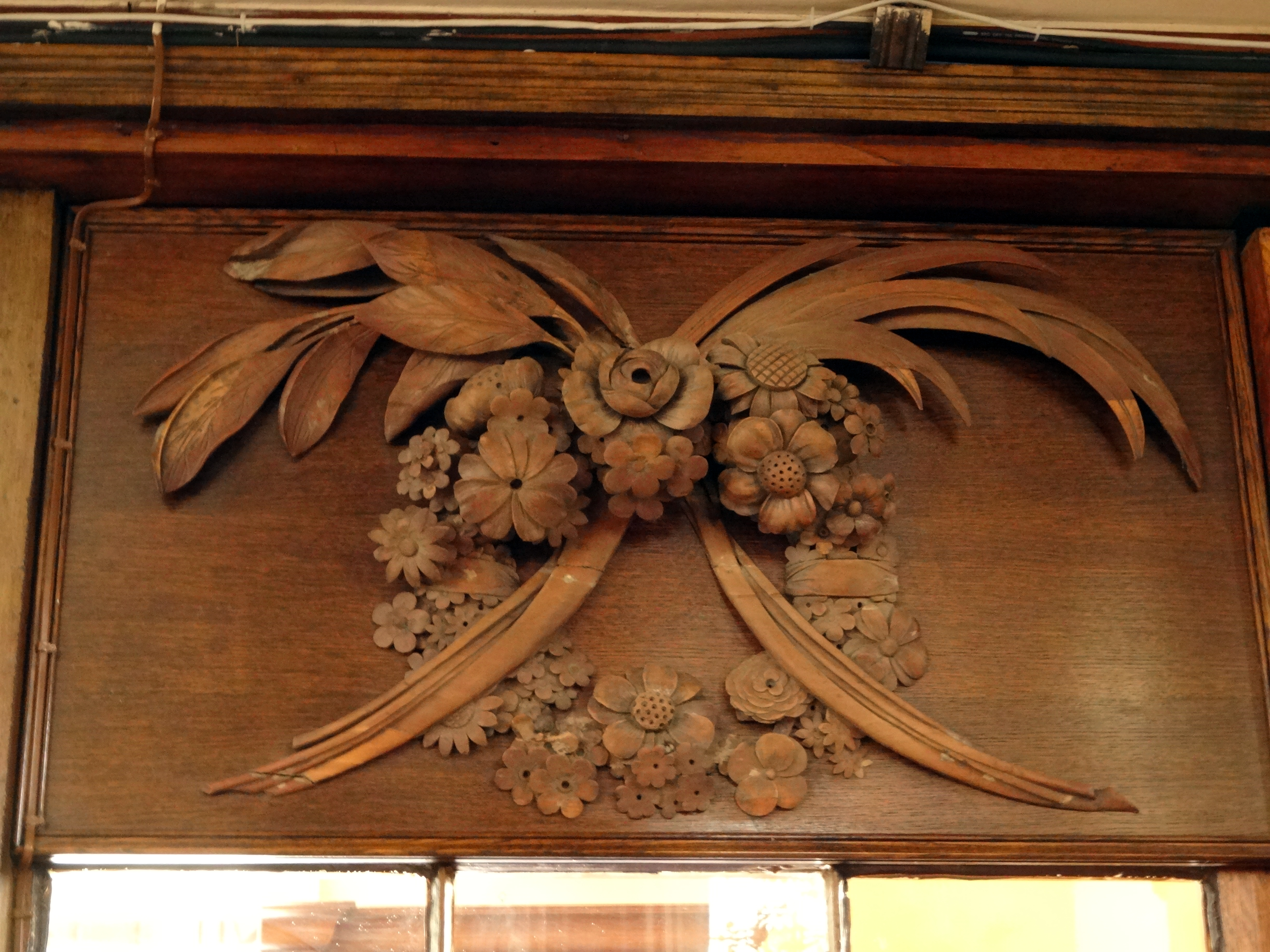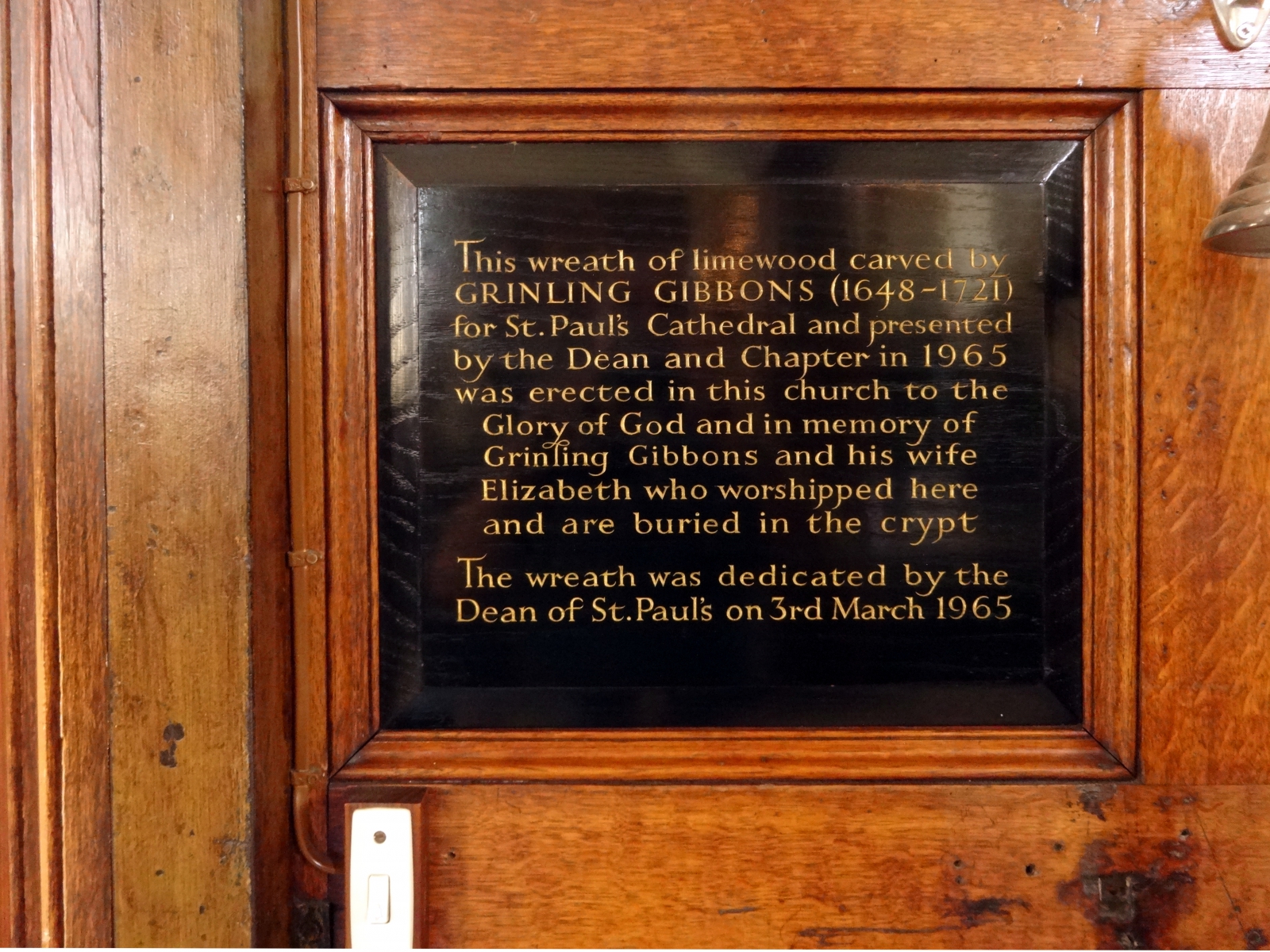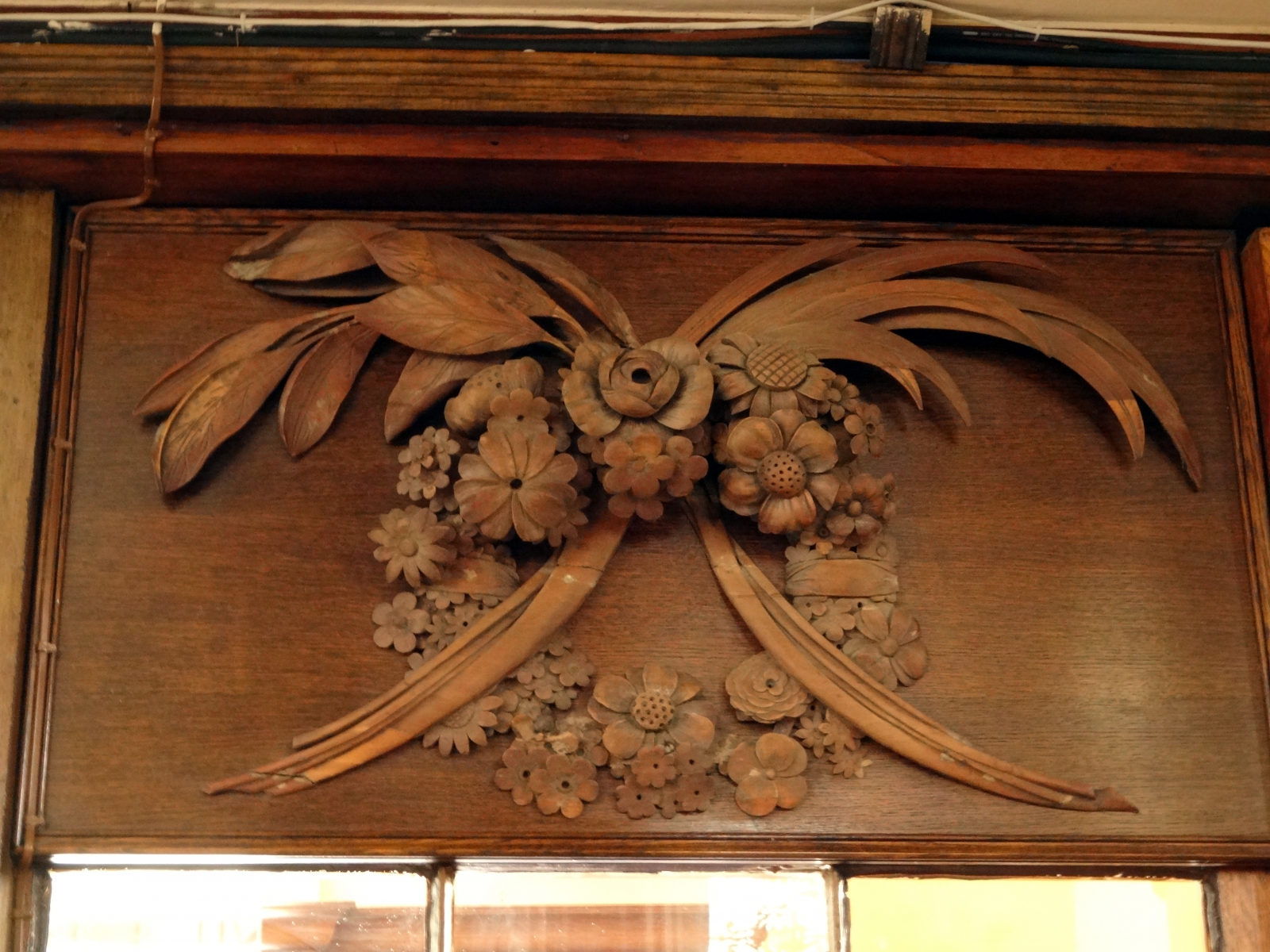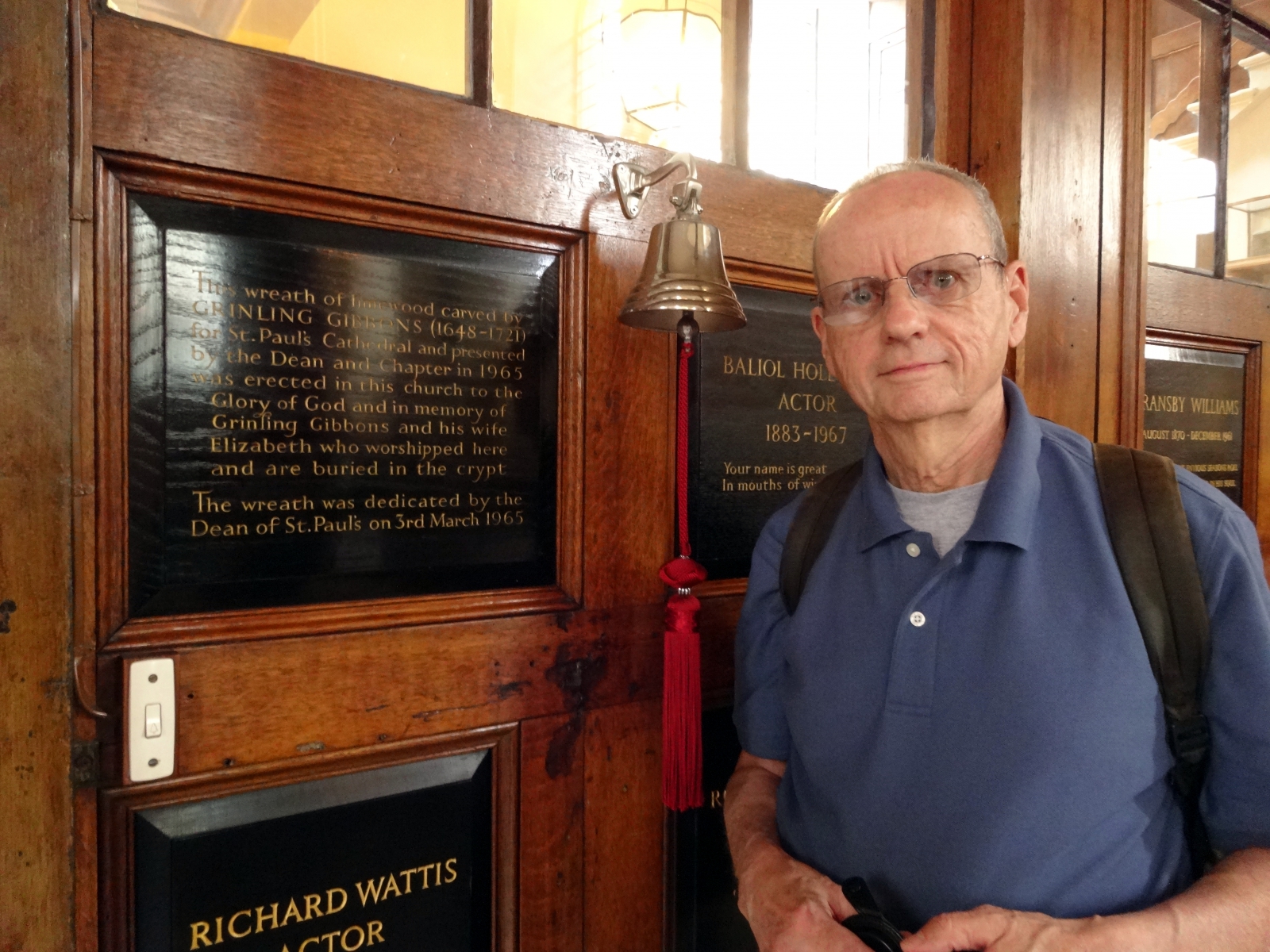
The last stop of our original tour was to a small church in Covent Garden that Grinling and Elizabeth Gibbons attended. They are buried in the church’s crypt.
Reading old demographic statistics, I was surprised to find that the average lifespan in Gibbons’ England was only 35 years. It doesn’t mean, however, that everyone died younger than that. In fact, Gibbons lived to 73. The factor that lowers the average so greatly is a very low rate of childhood survival; children succumbed to diseases which were fatal then, which we know how to manage today. Grinling and Elizabeth had 10 children. Only 2 survived to adulthood. I have not found much information about the Gibbons children who survived. Did they follow in their father’s work?
There is only one Gibbons carving in this church, one that was installed there in 1965. The Gibbons carving and a plaque serve as a memorial to the man who became the greatest baroque carver of his time, master carver to royalty, master sculptor to the crown.
It’s good that 300 years later, someone thought to create this memorial.



This ends our tour of Gibbons’ woodcarvings in central London. One of my goals, beyond seeing all of these wonders with my own eyes, was to bring more, and higher resolution, images of Gibbons’ woodcarvings to you and the internet. I’m very satisfied with what I have seen, and mostly satisfied with what I’ve been able to publish for you. Yet, there’s a lot more Gibbons beyond central London.
More Gibbons to see…
We visited the places we could easily access without driving on the wrong side of the road, and as many as we could reach during a short stay in London.
Other institutions where you can find Gibbons’ woodcarvings include Kensington Palace, Windsor Castle, Cambridge University and Oxford. Then there are the country homes or manor houses: Sudbury Hall (Derbyshire), Petworth House (West Sussex), Badminton House (Gloucestershire), Burghley House (Northamptonshire), Belton House (Lincolnshire), Blenheim Palace (Oxfordshire), as well as several in Scotland.
Of all of the manor houses, Petworth House looks the most inviting. The “Carved Room” in Petworth House contains what are acclaimed as outstanding Gibbons carvings surrounding two very large portraits. The room is also filled with carvings from many other woodcarvers, thus the name “Carved Room.” While only about 65 miles from central London, getting there by public transport is much more than a half-day journey, too long down and back for the time we had in London. Maybe during the next trip to London? If you go, see if you can take pictures and post them. The photography policy gives me doubts: ” Photography (without flash) is permitted in the house and historic kitchens, but not in the special rooms…”
Beyond the British Isles
Two great “trophy” panels reside in Italy. Trophy panels are a genre of woodcarving that exhibit a collection of many objects, related in some way, sometimes obvious, and sometimes only in the mind of the carver.
Esterly believes that the “Cosimo panel,” carved as a gift from King Charles II to Florence’s Grand Duke of Tuscany, Cosimo III de’ Medici, is Gibbons’ finest work. You will have difficulty finding online images of the Cosimo panel. There are some very good black and white images in Beard’s book and more extensive and detailed images in Esterly’s “Grinling Gibbons and the Art of Carving.” Online, only a few small images exist, the best in this article by the Victoria and Albert Museum. The dearth of easily accessible images is all the more reason to visit the Cosimo panel at the Pitti Palace in Florence. If you go, take some pictures and post them for us. Non-flash photography has been allowed in Pitti Palace since 2014.
The “Modena panel,” carved as a gift in memory of Charles II to Alfonso IV, Duke of Modena, who was the father of James II’s wife, (James II being Charles II’s brother.) The Modena panel is very different from the Cosimo panel, being a far more open collection of objects. It can be seen in both Beard’s and Esterly’s books, with Esterly going into more detail. You can also see the panel in room 22 of the Galleria Estense, Modena, Italy. I can’t find their photography policy. If allowed, take pictures for us.
Oh, by the way…
We visited St. Paul’s church a couple of times. The first time we visited we found it was closed for a private funeral. We came back a couple of days later. Both times, we found entertainers amusing crowds of several hundred people in the piazza between St. Paul’s and the Covent Garden Market building. Seeing entertainers in that piazza makes sense after learning that St. Paul’s church sits in the theater district and is known as “the Actors’ church.”
That Covent Garden Market building across the piazza once was a very active fresh produce market. Today it has become home for many upscale shops: Dior, Burberry, Chanel, chic bakery, a gelato shop, pubs and eateries. But there’s still an apple market. Across the street is the other kind of apple, an Apple (computer) store. One thing that makes the area more interesting is to read the history of how city planners wanted to raze many buildings in Covent Garden and “improve” the area. In the end, the residents of the area stopped those plans and improved the area themselves. Covent Garden thrives, full of people and activity.
When you plan your own Gibbons tour, consider books by Beard and Esterly and a database of English sculptures that I have found to be very helpful. See “A Biographical Dictionary of Sculptors in Britain, 1660-1851.” Use this “Search works” form to quickly find Gibbons’ work. This “Biographical Dictionary” includes the most comprehensive list of Gibbons’ work that I’ve found, in wood and stone.
Your comments are welcome: